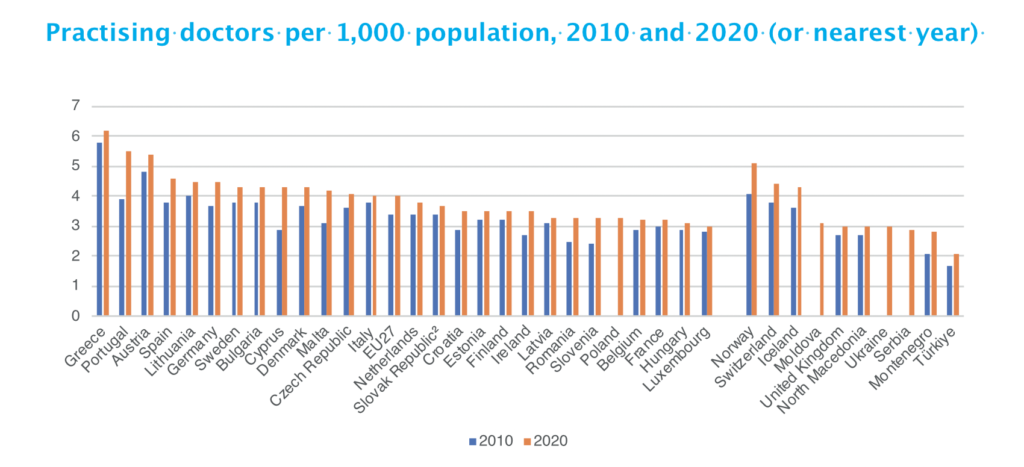Ireland lags in doctors and beds but leads in nurses per capita

A comparative analysis of European healthcare carried out by the OECD has found Ireland to be performing worse than the European average in unmet healthcare needs, doctors per capita, and hospital beds per capita, but above the average in nurses per capita and ratio of nurses to doctors.
Published on a biannual basis, 2022’s edition of the OECD’s Health at a Glance: Europe allows for an opportunity survey the Irish health system’s performance in the European context.
Unmet healthcare needs
The OECD defines unmet healthcare needs as there being a time in the previous 12 months whereby people surveyed “felt they needed medical care… but did not receive it”, with a follow-up question then relating to the cause of that unmet need. The report focuses on three reasons: prohibitive costs, excessive travel distance, and overly long waiting lists. The resulting data is then broken down into three categories: those of the lowest quintile of income, the total population, and those of the highest quintile of income.

It is only among those of the highest quintile of income that Ireland performs better than the EU27 average, with 0.5 per cent of Irish high-income earners stating that they had experienced unmet healthcare needs in the previous 12 months, as opposed to a European average of 0.7 per cent of high-income earners. 2 per cent of the State’s total population stated that they had had healthcare needs not met in the previous year, as compared to a European average of 1.8 per cent, and 3.9 per cent of low-income earners in Ireland stated the same, compared to a European average of 3.8 per cent. While Ireland performs worse than the European average in two of the three categories, countries such as France, Slovakia, Romania, Latvia, Finland, Greece, and Estonia all recorded rates worse than the European average in all three categories.
Doctors and nurses per capita
Ireland also performs under the European average with regard to the number of doctors per 1,000 of population. Having had 2.7 doctors per 1,000 in 2010, when the EU27 average was 3.4, the State had 3.5 doctors per 1,000 as of 2020, when the EU27 average was 4.0. Leading countries in this category include Greece (5.8 in 2010 and 6.2 in 2020), Portugal (3.9 in 2010 and 5.5 in 2020), and Austria (4.8 in 2010 and 5.4 in 2020). The share of different categories of doctors in Ireland also differs greatly from the European average, with 25 per cent of Ireland’s doctors being GPs, compared to a European average of 20 per cent, and just 46 per cent of Irish doctors being specialists, compared to an average of 69 per cent.
While Ireland’s number of nurses per capita is ahead of the EU27 average (7.4 and 8.3 nurses per 1,000 population in 2010 and 2020 respectively), the figures for Ireland show that the ratio of nurses to 1,000 population have slightly dropped from 12.9 in 2010 to 12.8 in 2020. Despite this, the State still retains the second-highest level of nurses per capita among the countries surveyed, with only Finland recording a better ratio.
Despite having 12 nurses per 1,000 in population in 2010, Finland has since surpassed Ireland’s ratio, having 13.6 nurses per 1,000 population as of 2020. One possible explanation for the slight fall in nurse ratio in Ireland may be that the remuneration of hospital nurses ratio to the national average wage was 1.2, exactly in line with the European average, but behind countries such as Greece, Hungary, Poland, Czech Republic, Spain, Luxembourg, and Belgium. Such data suggests that, while nursing delivers an above average wage in Ireland and is a common career choice, it does not deliver the remuneration needed to retain and indeed grow the nurses to population ratio as the Irish population continues to grow.
Given its lower-than-average rate of doctors to population and higher-than-average rate of nurses to population, it is perhaps inevitable that Ireland would have an above average ratio of nurses to doctors, recording a rate of 3.2 as compared to the EU27 average of 2.2. This ratio places Ireland amongst the best performing European states in this regard, on par with Slovenia, and behind only France, Belgium, Finland, and Luxembourg.
Hospital beds
Ireland is among the worst performing states in the EU on the metric of hospital beds per 1,000 population as of the 2020 data featured in the OECD’s report, recording a rate of 2.9 beds per 1,000 that places it above only Finland, Denmark, and Sweden.
While data for Ireland’s 2010 rate is not provided, it is notable that all states surveyed – the EU27, Serbia, Switzerland, North Macedonia, Montenegro, Norway, Türkiye, Iceland, and the UK – showed a decrease in beds per 1,000 from 2010 to 2020, except for Bulgaria, Romania, Serbia, and Türkiye. The most pronounced of these falls is that of Finland, which fell from a rate of 5.9 hospital beds per 1,000 in 2010 to 2.8 in 2020.
While the onset of the Covid-19 pandemic since the collation of the 2020 data included will no doubt have led to many of the states increasing the bed to population ratios and arresting the slide that took place throughout the 2010s, the report shows that there remains much work to be done in both Ireland and further afield in Europe.





